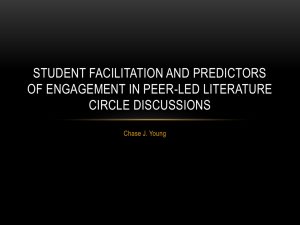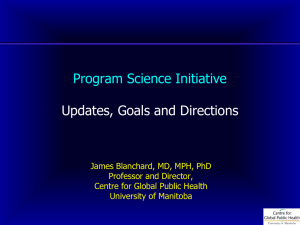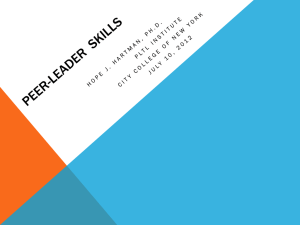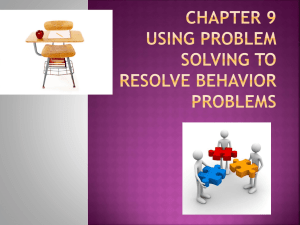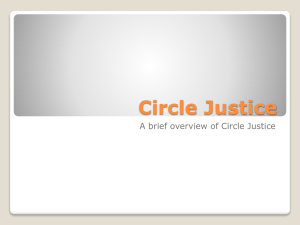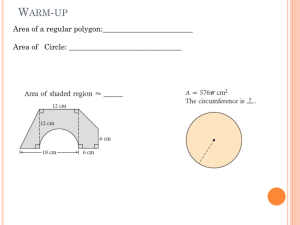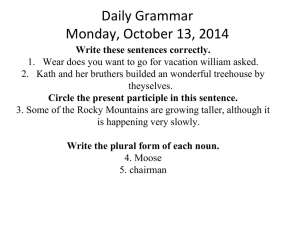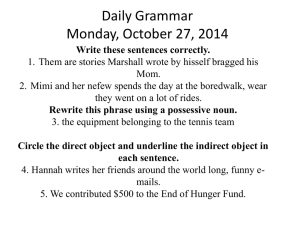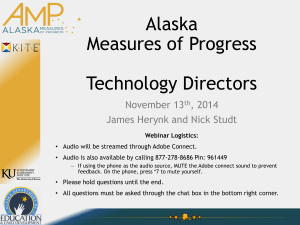Student facilitation and predictors of engagement in peer
advertisement
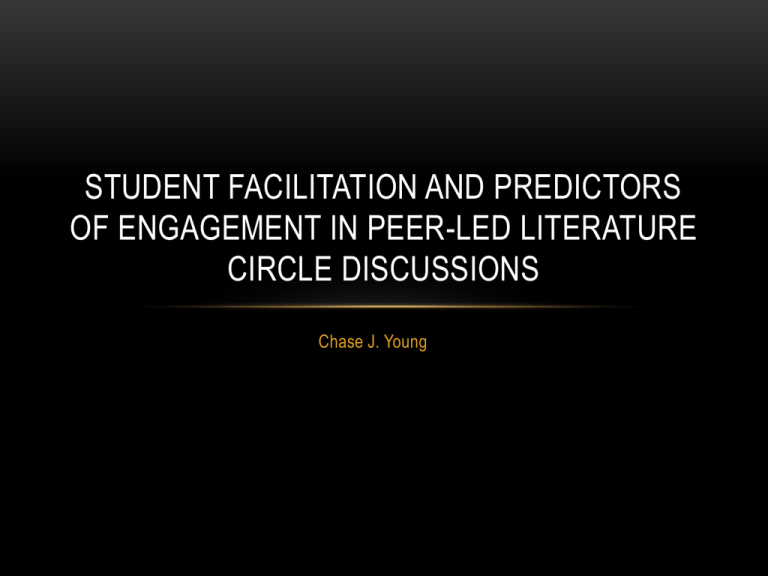
STUDENT FACILITATION AND PREDICTORS OF ENGAGEMENT IN PEER-LED LITERATURE CIRCLE DISCUSSIONS Chase J. Young PREVIOUS LITERATURE CIRCLE RESEARCH • Research in literature circles has typically focused on implementation and design (Almasi, O'Flahavan, & Arya, 2001; Bond, 2001; Brabham & Villaume, 2000; Burns, 1998; Clark, 2009; Daniels, 2002). PREVIOUS LITERATURE CIRCLE RESEARCH • Findings on student perceptions of literature circles usually note that students enjoy literature circles (Daniels, 2002; Flowerday, Schraw, & Stevens, 2004; Peralta-Nash & Dutch, 2000). PREVIOUS LITERATURE CIRCLE RESEARCH • A team of teachers and researchers (Paradis, Chatton, Boswell, Smith, & Yovich, 1991) collaborated to devise a rubric that monitored comprehension during discussion. PREVIOUS LITERATURE CIRCLE RESEARCH • Subsequent research (McElvain, 2010) used a pre/post-test to measure comprehension. McElvain studied the resulting comprehension from literature circle discussions and indicated that students were in fact developing their understanding of the text through dialogue, a finding that aligns with social constructivist theory (Vygotsky, 1978). THE PROBLEM • Some Literature Circles are Unproductive GAP IN RESEARCH • Investigating individual factors or behaviors that may influence LC discussions PILOT STUDY • In a pilot study conducted with thirdgraders, a regression correlated higher reading ability, increased extroversion, and lack of conscientiousness with increased quality of verbal engagement RESEARCH QUESTIONS • To what extent did personality factors, reading proficiency, and gender explain the quality of verbal engagement in literature circle discussions? • How did students facilitate peer-led literature circle discussions? OVERVIEW OF THESE LCS • Goal: to create and support the environment for analytical (higher-level) thinking and reading skills through a community of readers, affording the unique opportunity for sharing and learning with peers, therefore creating the optimal self-directed, student-choice learning situation • Students read designated chapters • They wrote down “burning questions” and took note of interesting parts of the story • Students discussed the text in small groups ASSUMPTIONS/LIMITATIONS • Teacher controls text difficulty to promote comprehension • Small N (17) resulting in low degrees of freedom and low power METHOD • The researcher video-taped 17 fourth-grade students’ literature circle discussions for a total of 136.7 minutes collected on two separate occasions across two weeks. To answer the first question student contributions in discussions were quantified into a measure of quality of verbal engagement score (cf. Costa & Kallick, 2000). This quality of verbal engagement score served as the dependent variable in a multiple regression. The seven independent variables were (1) extroversion, (2) agreeableness, (3) conscientiousness, (4) emotional stability, (5) openness, (6) reading ability, and (7) gender. METHOD – CALCULATING QVE METHOD – TEN ITEM PERSONALITY INVENTORY METHOD – READING ABILITY • This project used the spring 2012 administration of the Measure of Academic Progress (MAP; Northwest Evaluation Association, 2011) to determine students’ reading achievement. The Reading MAP test is a computer assessment that assesses student reading achievement and progress based on grade-level norms. The MAP provides a percentile score based on the normed performance of students at the same grade level. The test is an adaptive test using item-response theory where the test reacts to student responses, thus becoming more difficult or easier depending on prior student performance. RESULTS – REGRESSION MODEL RESULTS – POST HOC REGRESSION MODEL QUANTITATIVE RESULTS • Emotional Stability was significant (p<.05) in regression • This did not corroborate the pilot study, and needs further research • Group size was significant in post hoc regression (p<.01) • The post hoc regression model was also significant (p<.05) and explained 66% of the variance DISCOURSE ANALYSIS THEORETICAL MODIFICATIONS • Scaffolding • Not adding support, but carefully removing support to foster independence • Students in LCs should be closer to independence METHODOLOGICAL MODIFICATIONS • Contextual Changes • Lower number of subjects (N=17) • Limited to one teacher METHODOLOGICAL MODIFICATIONS • Coding Changes: Tharp and Gallimore (1988) deemed insufficient and felt forced on the data • Modeling – What is it in the context of peer-led LCs? • Contingency Managing – Should students be responsible for this? • Feedback – Does all feedback facilitate discussion? • Questioning – Do all questions instigate deeper level discussions? • Cognitive Structuring – Should this definition include how the brain changes? • Instructing – Is this the job of the students? METHODOLOGICAL MODIFICATIONS • Coding Changes: Li et al. (2007) deemed insufficient and felt forced • Planning and Organizing – Should this be done by the teacher prior to LCs? • Topic Control – How do students control the topic? • Acknowledgement – Is mere acknowledgement beneficial in LCs? • Argument Development – Development assumes a thread of discourse rather than an utterance • Turn Management – Does this inhibit free-flowing discussions? FLOW OF CODING FACILITATIVE FUNCTIONS THARP AND GALLIMORE LI ET AL. (2007) • Modeling – Eliminated • Planning and Organizing – Eliminated • Contingency Managing – Eliminated • Feedback – Included only if elaborative • Topic Control – Renamed Topic Management if facilitative (exploratory talk or confessional) • Questioning – Included in Exploratory Talk if high-level • Acknowledgement – Eliminated • Cognitive Structuring – Eliminated • Instructing – Eliminated • Argument Development – Eliminated • Turn Management – Eliminated FLOW OF CODING FACILITATIVE FUNCTIONS • Deemed Facilitative • Non-Facilitative • Exploratory Talk (CC) • Feedback • Elaborative Feedback (CC) • Unrelated • Topic Management (CC) • Confessionals (Open) • Accountability (Open) QUALITATIVE RESULTS The researcher observed students facilitating discussions in five ways: • Exploratory Talk • • Elaborative Feedback • • Introducing important topics and big ideas as well as changing topic through facilitation Confessionals • • Agreeing or disagreeing and providing reasoning or text evidence Topic Management • • Asking questions that are open ended that expect high-level responses and statements that allow for debate Admitting when meaning breaks down and asking for help from group members Accountability • Making sure all group members participate and back up their contributions and questions with text-evidence FURTHER RESEARCH • Teaching Facilitative Functions to improve student discourse • Facilitative Function Order of Importance • Benefits of LCs on higher and lower readers • Personality’s impact on LC discussions • Personality’s impact on LC discussions across grade levels • Group size and quality of LC discussions • Measuring comprehension on the go LESSONS LEARNED • Recruiting is not as easy as it seems • The importance of training participating teachers and quality control • When number of subjects decrease, the ability to look more closely at the data increases • Expectations that students can proficiently use sophisticated methods such as scaffolding • Forcing frameworks on data • The nonlinear process of discourse analysis utilizing the constant comparative and grounded theory methods • Research can leave us with more questions than answers
